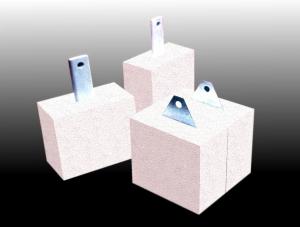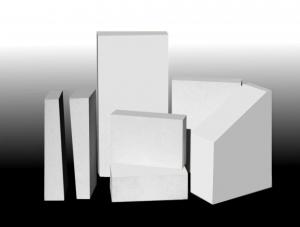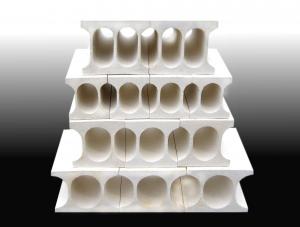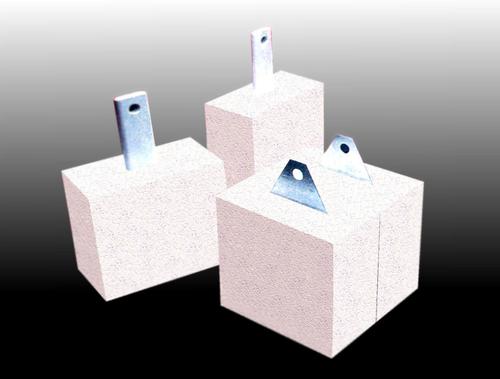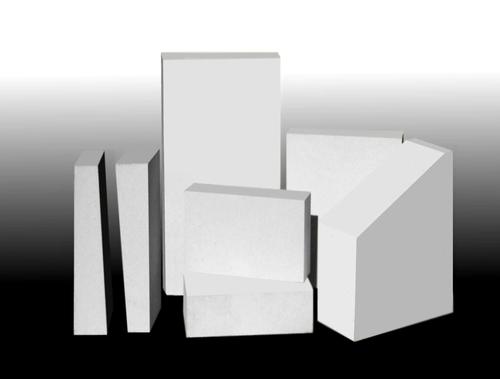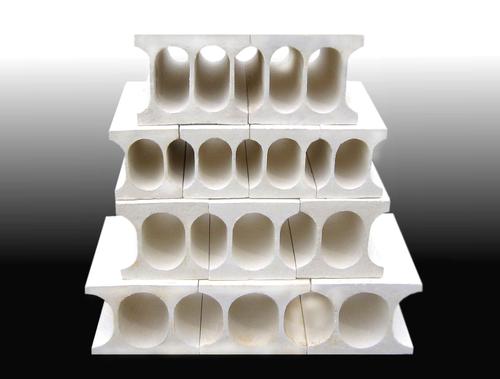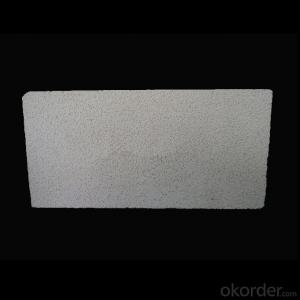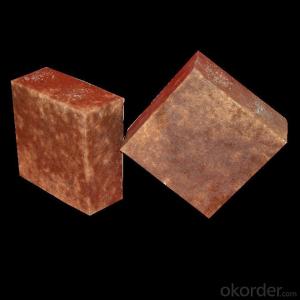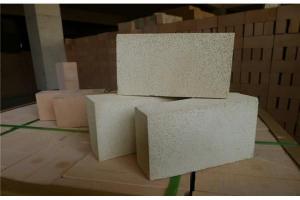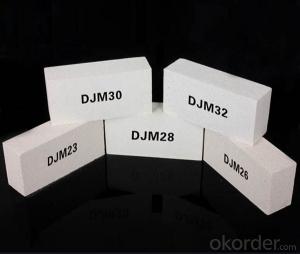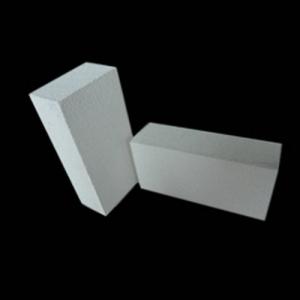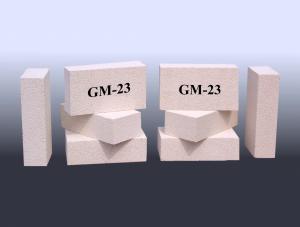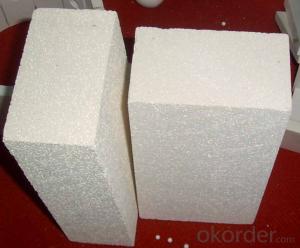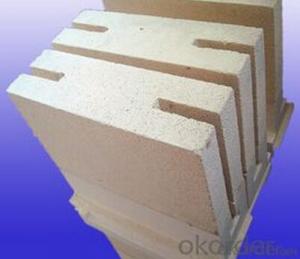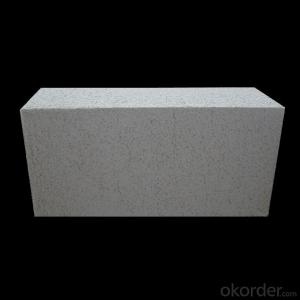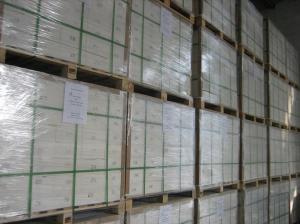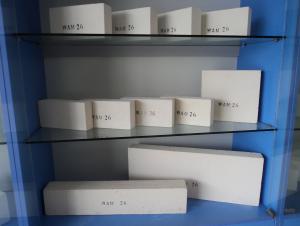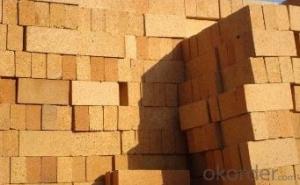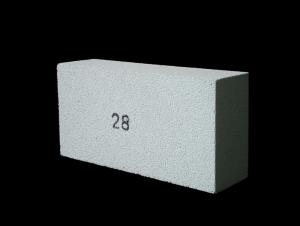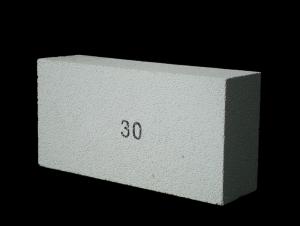Insulating Fire Brick GJM Series - Refractory and Insulating Fire Brick
- Loading Port:
- Shanghai
- Payment Terms:
- TT OR LC
- Min Order Qty:
- 17 m.t.
- Supply Capability:
- 10000 m.t./month
OKorder Service Pledge
OKorder Financial Service
You Might Also Like
General Information
CMAX insulating firebricks are classified under temperature between 1300℃ to 1700℃, manufactured from high purity alumina clay.
1. Lower content of iron, alkaline and impurities, good high temperature properties.
2. Homogeneous structure, light weight, energy saving because lower heat storage in the furnace during cooling cycles.
3. High strength, good thermal shock resistance under high temperature.
4. Precise sizes due to grinding and shaping after sintering, which meets the requirement of construction.
5. Max service temp: Up to 1730C (3160F)
Feature
Light weight and low thermal conductivity
Low heat storage
Low iron and impurities
High thermal shock resistance
Application
CMAX insulating firebricks can be used as a hot face lining directly exposed to the heat or as a backup insulation layer in iron and steel mills, non-ferrous foundries, petrochemical, ceramic, glass.
ITEM | GJM30 | GJM28 | GJM26 | GJM23 |
Classification Temperature, ℉/℃ | 3000/1650 | 2800/1540 | 2600/1430 | 2300/1260 |
Bulk Density,g/cm³ | ≤1.0 | ≤0.9 | ≤0.8 | ≥0.5 |
Reheating Linear Change, % | ≤0.9 (1550℃,12 h) | ≤0.8 (1510℃,12 h) | ≤0.7 (1410℃,12 h) | ≤0.5 (1230℃,12 h) |
Al2O3 Content, % | ≥75 | ≥65 | ≥55 | ≥45 |
Fe2O3 Content, % | ≤0.5 | ≤0.6 | ≤0.7 | ≤1.0 |
Thermal Conductivity: | ||||
800℃, w/m.k | ≤0.39 | ≤0.37 | ≤0.35 | ≤0.18 |
1000℃, w/m.k | ≤0.43 | ≤0.41 | ≤0.39 | ≤0.20 |
1200℃, w/m.k | ≤0.48 | ≤0.46 | ≤0.43 | --- |
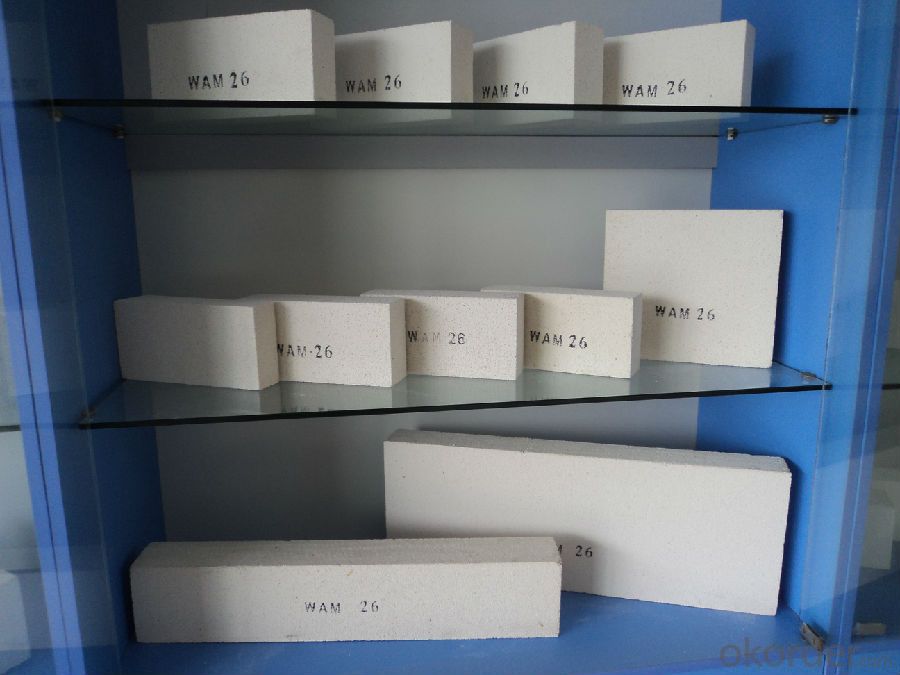
- Q: How do insulating fire bricks affect energy efficiency?
- Insulating fire bricks play a crucial role in improving energy efficiency in various applications. These bricks are designed to have low thermal conductivity, which means they are efficient in minimizing heat transfer. By reducing the amount of heat that escapes or enters a system, insulating fire bricks help to conserve energy and maintain optimal temperature levels. In industrial furnaces and kilns, insulating fire bricks act as a barrier, preventing heat from dissipating into the surrounding environment. This leads to reduced energy consumption as the heat is retained within the system, allowing for more efficient and cost-effective operation. Additionally, insulating fire bricks can help to reduce the time required for the system to reach and maintain the desired temperature, further enhancing energy efficiency. In residential and commercial buildings, insulating fire bricks are used in the construction of fireplaces, stoves, and chimneys. These bricks effectively trap heat within the combustion chamber, preventing it from escaping through the walls. As a result, the heat generated by the fire is utilized more efficiently, reducing the need for additional heating sources and ultimately saving energy. Furthermore, insulating fire bricks are also employed in the insulation of pipelines, boilers, and other equipment that require thermal protection. By reducing heat transfer through these components, energy losses are minimized, leading to improved energy efficiency. Overall, insulating fire bricks play a significant role in enhancing energy efficiency by minimizing heat loss, maximizing heat retention, and optimizing temperature control in various applications. Their low thermal conductivity properties make them an essential component in systems where energy conservation and cost-effectiveness are crucial considerations.
- Q: Can insulating fire bricks be used in the construction of thermal insulation floors?
- Yes, insulating fire bricks can be used in the construction of thermal insulation floors. Insulating fire bricks are specially designed to have low thermal conductivity, which means they can effectively prevent the transfer of heat. This makes them an excellent choice for thermal insulation applications, including floors. By using insulating fire bricks in the construction of thermal insulation floors, the heat loss from the floor can be significantly reduced, leading to improved energy efficiency and cost savings. Additionally, insulating fire bricks are lightweight and easy to install, making them a practical choice for construction projects. Overall, insulating fire bricks are a suitable and effective option for incorporating thermal insulation into floors.
- Q: Can insulating fire bricks be used in refractory castings?
- Yes, insulating fire bricks can be used in refractory castings. Insulating fire bricks are lightweight and have high insulating properties, making them suitable for applications that require thermal insulation. This includes refractory castings, which are used to create linings in furnaces, kilns, and other high-temperature equipment. The insulating fire bricks can be used as a layer or as a part of the refractory casting mix to provide thermal insulation and reduce heat loss. Additionally, their low thermal conductivity helps in minimizing energy consumption and maintaining high temperatures within the casting.
- Q: Is the quality of brick made of small-sized self insulation block equipment the same as that of large block brick equipment?
- Recently, a lot of people have encountered this problem, Silver Horse understand, in fact, the brick machine is only the production of different production, the quality of the bricks produced are the same.
- Q: Are insulating fire bricks chemically resistant?
- Insulating fire bricks are generally chemically resistant to a wide range of substances. These bricks are typically made from high-quality refractory materials such as alumina, silica, or a combination of both. These materials have excellent resistance to chemical attack, making insulating fire bricks highly resistant to the corrosive effects of various chemicals. However, it is important to note that the chemical resistance of insulating fire bricks can vary depending on the specific composition and manufacturing process. While they are generally resistant to most chemicals, there may be certain aggressive chemicals or extreme conditions that could potentially degrade or erode the bricks over time. To ensure the optimal chemical resistance of insulating fire bricks, it is recommended to consult the manufacturer's specifications or seek expert advice for specific applications. This will help ensure that the bricks are suitable for the intended chemical environment and will perform reliably over the desired lifespan.
- Q: Are insulating fire bricks resistant to carbon dioxide?
- Insulating fire bricks, also known as refractory bricks, are designed to withstand high temperatures and are generally resistant to various chemicals and gases. However, their resistance to carbon dioxide may vary depending on the specific type and composition of the insulating fire brick. Carbon dioxide (CO2) is a non-flammable gas that is usually present in the atmosphere and is released during the combustion of carbon-based fuels. In most cases, insulating fire bricks have a high resistance to carbon dioxide due to their high melting point and the presence of refractory materials such as alumina and silica. However, prolonged exposure to high concentrations of carbon dioxide, especially at elevated temperatures, can cause some insulating fire bricks to undergo chemical reactions that may lead to degradation or reduced performance. It is important to consider the specific application and environment in which the insulating fire bricks will be used. If the insulating fire bricks are part of a furnace or kiln that generates significant amounts of carbon dioxide, it is advisable to choose bricks specifically designed for such conditions. These bricks may have additional protective coatings or higher chemical resistance to ensure their longevity and performance. In summary, while insulating fire bricks generally have good resistance to carbon dioxide, it is important to consider the specific type of brick and the conditions under which it will be used to ensure optimal performance and longevity.
- Q: Are insulating fire bricks resistant to alkali vapor attack?
- Insulating fire bricks are known for their general resistance to alkali vapor attack. They are crafted from high-quality refractory materials like fire clay or silica, which possess exceptional resistance to chemical assaults, including alkali vapor. These bricks are engineered to endure extreme temperatures and challenging surroundings, rendering them suitable for applications where alkali vapor may be present, such as in industrial furnaces, kilns, and incinerators. However, the level of resistance may vary depending on the specific composition and manufacturing process employed for these insulating fire bricks. To ensure compatibility with alkali vapor exposure, it is advisable to refer to the manufacturer's specifications or seek expert advice.
- Q: Can insulating fire bricks be used in fireplaces?
- Yes, insulating fire bricks can be used in fireplaces. Insulating fire bricks are specifically designed to withstand high temperatures and provide excellent insulation, making them suitable for use in fireplaces. They are capable of withstanding temperatures up to 3000°F (1650°C), which is well within the operating range of most fireplaces. These bricks are made from special materials that have low thermal conductivity, allowing them to retain heat and prevent it from escaping the fireplace. This insulation property helps to improve the efficiency of the fireplace by keeping the heat inside the firebox and preventing it from dissipating into the surrounding area. Additionally, insulating fire bricks are lightweight, durable, and easy to install, making them a popular choice for fireplace construction or renovation projects.
- Q: What are the different sizes and shapes available for insulating fire bricks?
- Insulating fire bricks come in various sizes and shapes to cater to different applications and requirements. The sizes of insulating fire bricks typically range from standard sizes like 9" x 4.5" x 2.5" (commonly referred to as "9-inch bricks") to smaller sizes like 9" x 4.5" x 1". These standard sizes are widely used in the construction of fireplaces, kilns, furnaces, and other high-temperature applications. In addition to standard sizes, insulating fire bricks are also available in custom sizes, allowing for greater flexibility in design and construction. These custom sizes can vary depending on the manufacturer, but they generally follow the same width and length measurements as the standard bricks. Regarding the shape, insulating fire bricks are commonly rectangular or square-shaped. The rectangular shape is the most common and versatile, allowing for easy installation and arrangement in various structures. Square-shaped bricks are also available but may be less commonly used. It's worth noting that insulating fire bricks can be further categorized based on their density or insulation value. These bricks are typically classified into three categories: low-density, medium-density, and high-density. Each category has different insulating properties, with low-density bricks offering the highest insulation value. Overall, the wide range of sizes and shapes available for insulating fire bricks allows for customization and adaptability to different construction projects, ensuring optimal insulation and heat retention in high-temperature applications.
- Q: Are insulating fire bricks resistant to vibrations?
- Insulating fire bricks, although renowned for their exceptional thermal insulation properties, usually lack resistance against vibrations. Typically, these bricks are crafted from lightweight materials like ceramic fibers, vermiculite, or perlite, which do not possess notable capabilities to dampen or absorb vibrations. Hence, if a particular application necessitates vibration resistance, it would be prudent to explore alternative materials or designs that are better suited for such circumstances.
Send your message to us
Insulating Fire Brick GJM Series - Refractory and Insulating Fire Brick
- Loading Port:
- Shanghai
- Payment Terms:
- TT OR LC
- Min Order Qty:
- 17 m.t.
- Supply Capability:
- 10000 m.t./month
OKorder Service Pledge
OKorder Financial Service
Similar products
Hot products
Hot Searches
Related keywords
